Attached files
| file | filename |
|---|---|
| EX-99.1 - EXHIBIT 99.1 UCP PRESS RELEASE Q2 2016 - VIDLER WATER RESOURCES, INC. | ex991-ucppressreleaseq2201.htm |
| 8-K - FORM 8-K FOR UCP PRESS RELEASE Q2 2016 - VIDLER WATER RESOURCES, INC. | form8-kucpq2201610q.htm |
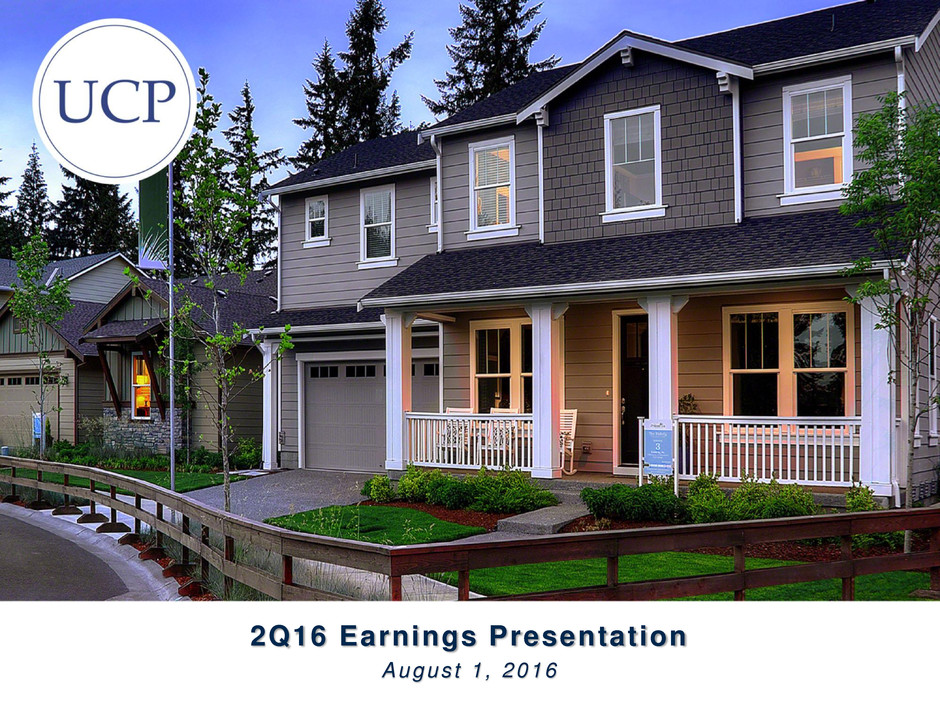
2Q16 Earnings Presentation
Augus t 1 , 2016
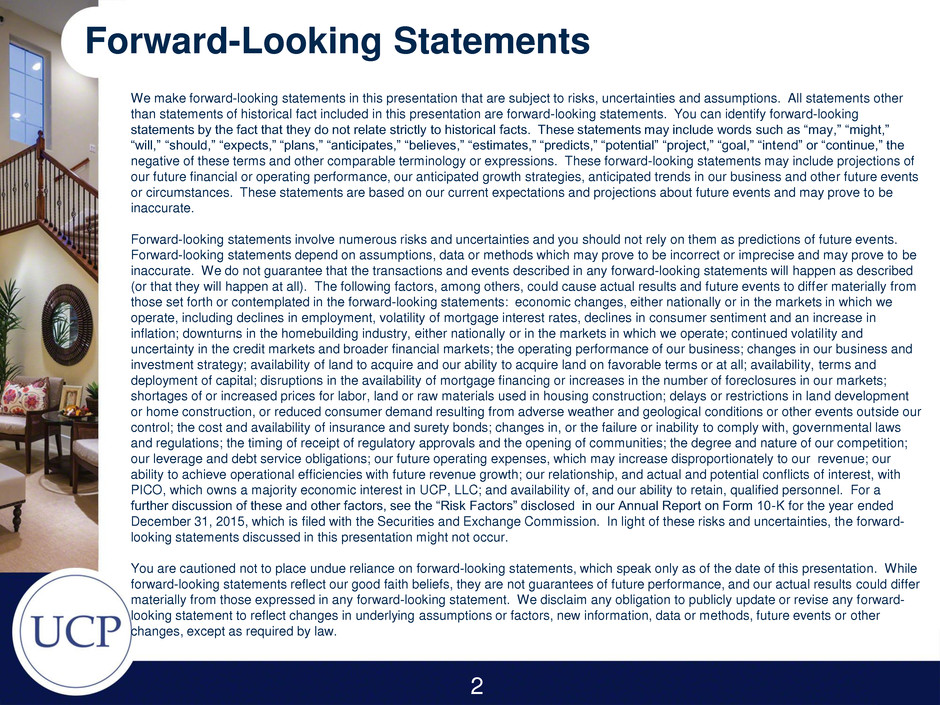
U
Forward-Looking Statements
We make forward-looking statements in this presentation that are subject to risks, uncertainties and assumptions. All statements other
than statements of historical fact included in this presentation are forward-looking statements. You can identify forward-looking
statements by the fact that they do not relate strictly to historical facts. These statements may include words such as “may,” “might,”
“will,” “should,” “expects,” “plans,” “anticipates,” “believes,” “estimates,” “predicts,” “potential” “project,” “goal,” “intend” or “continue,” the
negative of these terms and other comparable terminology or expressions. These forward-looking statements may include projections of
our future financial or operating performance, our anticipated growth strategies, anticipated trends in our business and other future events
or circumstances. These statements are based on our current expectations and projections about future events and may prove to be
inaccurate.
Forward-looking statements involve numerous risks and uncertainties and you should not rely on them as predictions of future events.
Forward-looking statements depend on assumptions, data or methods which may prove to be incorrect or imprecise and may prove to be
inaccurate. We do not guarantee that the transactions and events described in any forward-looking statements will happen as described
(or that they will happen at all). The following factors, among others, could cause actual results and future events to differ materially from
those set forth or contemplated in the forward-looking statements: economic changes, either nationally or in the markets in which we
operate, including declines in employment, volatility of mortgage interest rates, declines in consumer sentiment and an increase in
inflation; downturns in the homebuilding industry, either nationally or in the markets in which we operate; continued volatility and
uncertainty in the credit markets and broader financial markets; the operating performance of our business; changes in our business and
investment strategy; availability of land to acquire and our ability to acquire land on favorable terms or at all; availability, terms and
deployment of capital; disruptions in the availability of mortgage financing or increases in the number of foreclosures in our markets;
shortages of or increased prices for labor, land or raw materials used in housing construction; delays or restrictions in land development
or home construction, or reduced consumer demand resulting from adverse weather and geological conditions or other events outside our
control; the cost and availability of insurance and surety bonds; changes in, or the failure or inability to comply with, governmental laws
and regulations; the timing of receipt of regulatory approvals and the opening of communities; the degree and nature of our competition;
our leverage and debt service obligations; our future operating expenses, which may increase disproportionately to our revenue; our
ability to achieve operational efficiencies with future revenue growth; our relationship, and actual and potential conflicts of interest, with
PICO, which owns a majority economic interest in UCP, LLC; and availability of, and our ability to retain, qualified personnel. For a
further discussion of these and other factors, see the “Risk Factors” disclosed in our Annual Report on Form 10-K for the year ended
December 31, 2015, which is filed with the Securities and Exchange Commission. In light of these risks and uncertainties, the forward-
looking statements discussed in this presentation might not occur.
You are cautioned not to place undue reliance on forward-looking statements, which speak only as of the date of this presentation. While
forward-looking statements reflect our good faith beliefs, they are not guarantees of future performance, and our actual results could differ
materially from those expressed in any forward-looking statement. We disclaim any obligation to publicly update or revise any forward-
looking statement to reflect changes in underlying assumptions or factors, new information, data or methods, future events or other
changes, except as required by law.
2
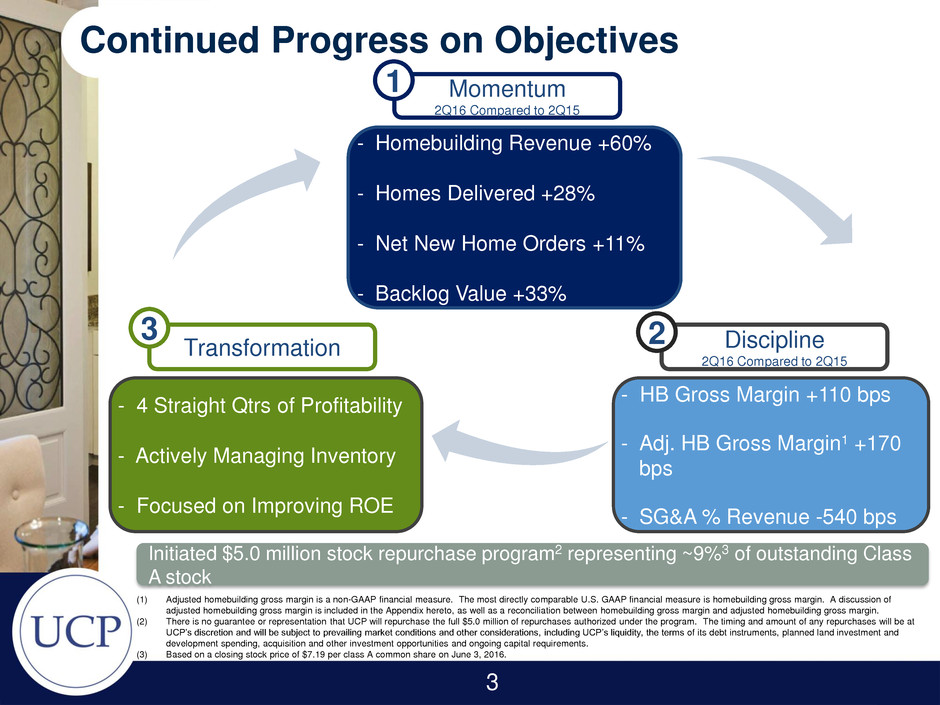
U
- HB Gross Margin +110 bps
- Adj. HB Gross Margin1 +170
bps
- SG&A % Revenue -540 bps
- 4 Straight Qtrs of Profitability
- Actively Managing Inventory
- Focused on Improving ROE
Momentum
2Q16 Compared to 2Q15
1
Discipline
2Q16 Compared to 2Q15
2
Transformation
3
- Homebuilding Revenue +60%
- Homes Delivered +28%
- Net New Home Orders +11%
- Backlog Value +33%
(1) Adjusted homebuilding gross margin is a non-GAAP financial measure. The most directly comparable U.S. GAAP financial measure is homebuilding gross margin. A discussion of
adjusted homebuilding gross margin is included in the Appendix hereto, as well as a reconciliation between homebuilding gross margin and adjusted homebuilding gross margin.
(2) There is no guarantee or representation that UCP will repurchase the full $5.0 million of repurchases authorized under the program. The timing and amount of any repurchases will be at
UCP’s discretion and will be subject to prevailing market conditions and other considerations, including UCP’s liquidity, the terms of its debt instruments, planned land investment and
development spending, acquisition and other investment opportunities and ongoing capital requirements.
(3) Based on a closing stock price of $7.19 per class A common share on June 3, 2016.
.
3
Initiated $5.0 million stock repurchase program2 representing ~9%3 of outstanding Class
A stock
Continued Progress on Objectives
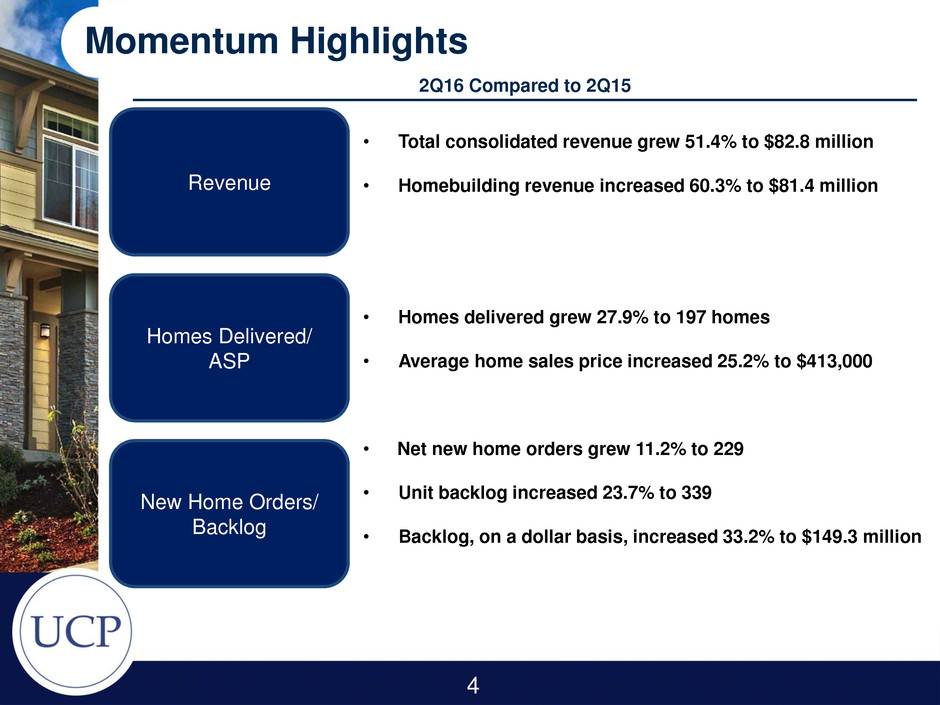
Momentum Highlights
• Total consolidated revenue grew 51.4% to $82.8 million
• Homebuilding revenue increased 60.3% to $81.4 million
• Homes delivered grew 27.9% to 197 homes
• Average home sales price increased 25.2% to $413,000
• Net new home orders grew 11.2% to 229
• Unit backlog increased 23.7% to 339
• Backlog, on a dollar basis, increased 33.2% to $149.3 million
2Q16 Compared to 2Q15
4
Revenue
Homes Delivered/
ASP
New Home Orders/
Backlog
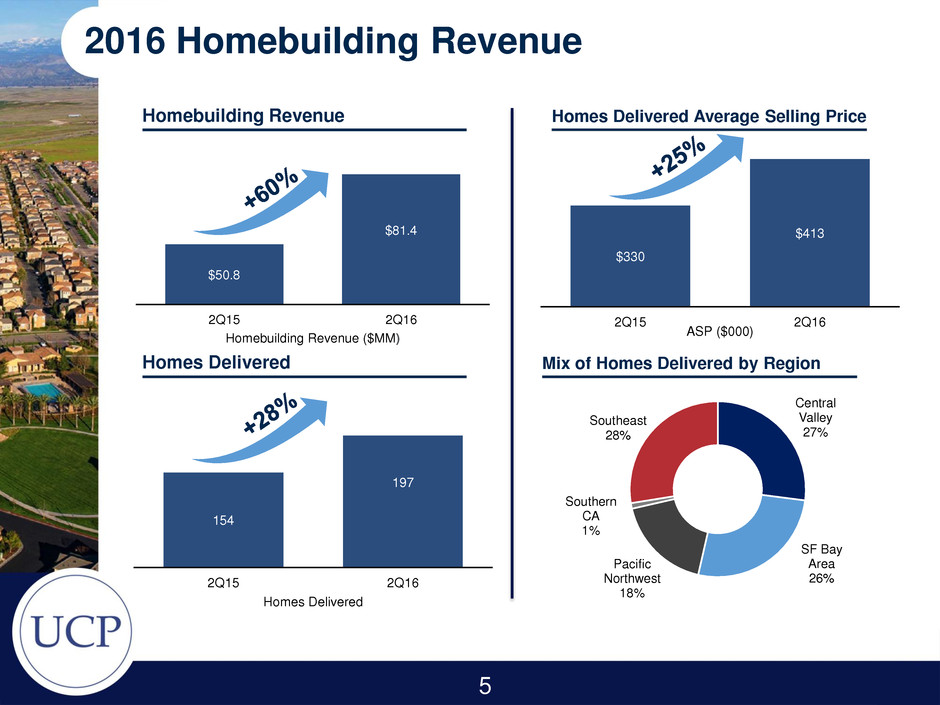
U
$330
$413
2Q15 2Q16
ASP ($000)
2016 Homebuilding Revenue
Homebuilding Revenue Homes Delivered Average Selling Price
Mix of Homes Delivered by Region Homes Delivered
$360k $370k
5
$50.8
$81.4
2Q15 2Q16
Homebuilding Revenue ($MM)
154
197
2Q15 2Q16
Homes Delivered
Central
Valley
27%
SF Bay
Area
26%
Pacific
Northwest
18%
Southern
CA
1%
Southeast
28%
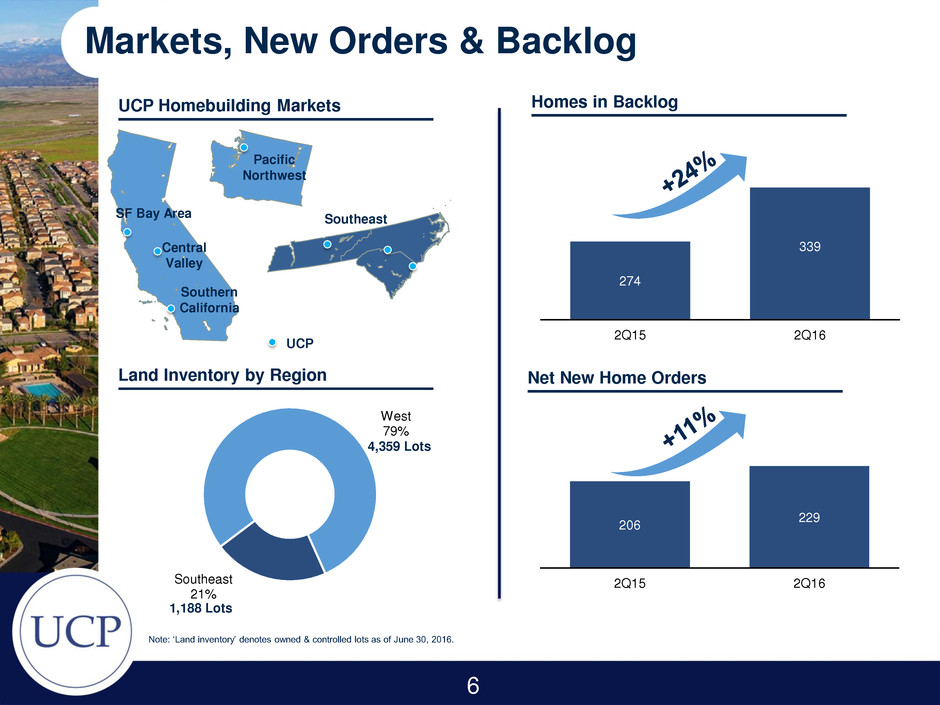
U
Markets, New Orders & Backlog
UCP Homebuilding Markets
Net New Home Orders Land Inventory by Region
$360k $370k
6
Southeast
Southern
California
Central
Valley
Pacific
Northwest
UCP
Note: ‘Land inventory’ denotes owned & controlled lots as of June 30, 2016.
Homes in Backlog
SF Bay Area
274
339
2Q15 2Q16
206
229
2Q15 2Q16
West
79%
Southeast
21%
4,359 Lots
1,188 Lots
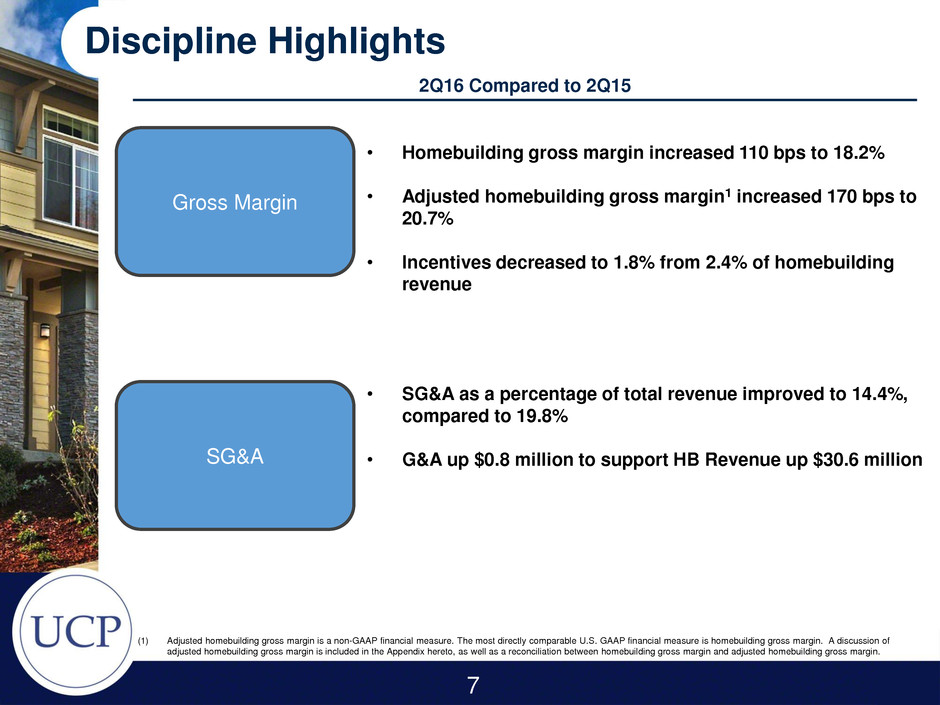
Discipline Highlights
• Homebuilding gross margin increased 110 bps to 18.2%
• Adjusted homebuilding gross margin1 increased 170 bps to
20.7%
• Incentives decreased to 1.8% from 2.4% of homebuilding
revenue
• SG&A as a percentage of total revenue improved to 14.4%,
compared to 19.8%
• G&A up $0.8 million to support HB Revenue up $30.6 million
2Q16 Compared to 2Q15
7
(1) Adjusted homebuilding gross margin is a non-GAAP financial measure. The most directly comparable U.S. GAAP financial measure is homebuilding gross margin. A discussion of
adjusted homebuilding gross margin is included in the Appendix hereto, as well as a reconciliation between homebuilding gross margin and adjusted homebuilding gross margin.
Gross Margin
SG&A

U
Gross Margin Expansion
8
Highlights Homebuilding Gross Margin
Disciplined and strengthened
margin profile
2Q16 homebuilding gross
margin up 110 basis points
year-over-year
2Q16 adjusted homebuilding
gross margin1 up 170 basis
points year-over-year
Favorable shift in product mix
of the homes sold
Ongoing cost savings
initiatives
Exiting the Bakersfield,
California market
(1) Adjusted homebuilding gross margin is a non-GAAP financial measure. The most directly comparable U.S. GAAP financial measure is homebuilding gross margin. A discussion of
adjusted homebuilding gross margin is included in the Appendix hereto, as well as a reconciliation between homebuilding gross margin and adjusted homebuilding gross margin.
Adj. Homebuilding Gross Margin1
19.0%
20.7%
2Q15 2Q16
17.1%
18.2%
2Q15 2Q16
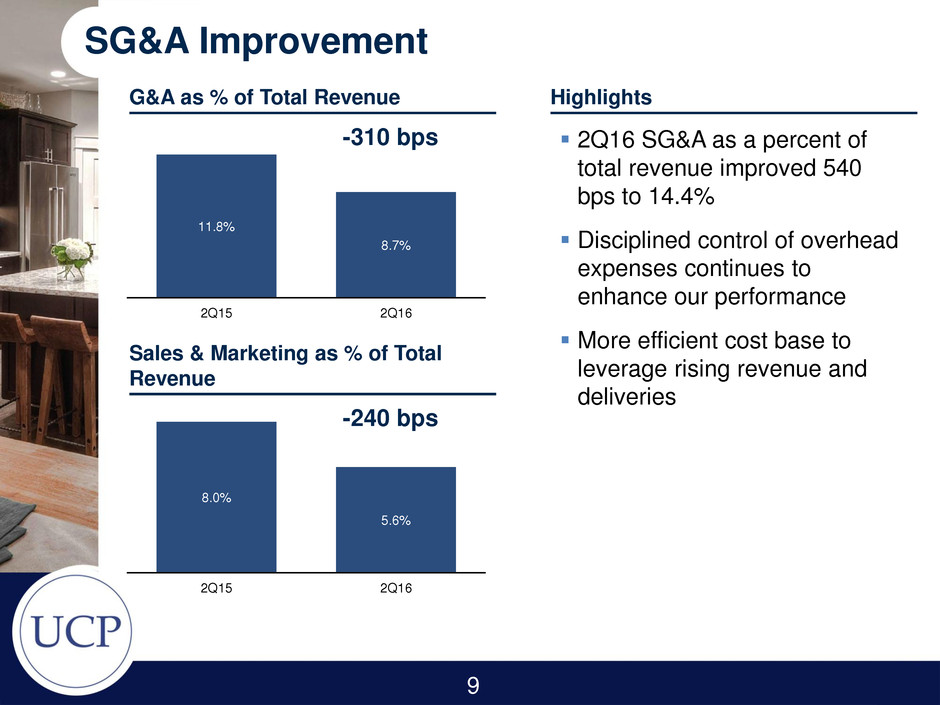
U
SG&A Improvement
9
Sales & Marketing as % of Total
Revenue
G&A as % of Total Revenue Highlights
2Q16 SG&A as a percent of
total revenue improved 540
bps to 14.4%
Disciplined control of overhead
expenses continues to
enhance our performance
More efficient cost base to
leverage rising revenue and
deliveries
11.8%
8.7%
2Q15 2Q16
8.0%
5.6%
2Q15 2Q16
-310 bps
-240 bps
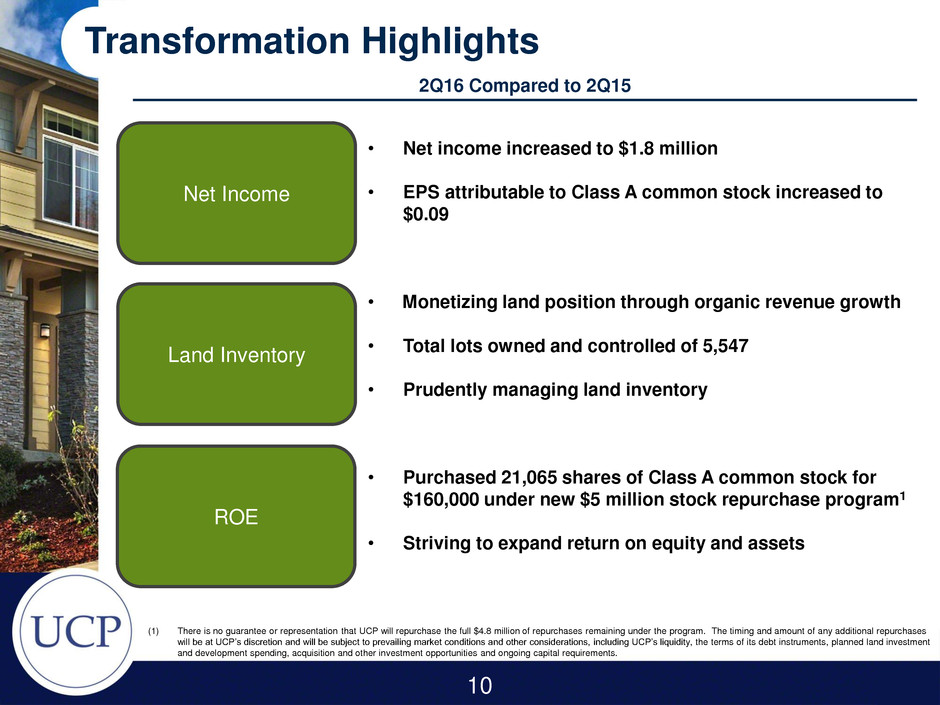
Transformation Highlights
• Net income increased to $1.8 million
• EPS attributable to Class A common stock increased to
$0.09
• Monetizing land position through organic revenue growth
• Total lots owned and controlled of 5,547
• Prudently managing land inventory
• Purchased 21,065 shares of Class A common stock for
$160,000 under new $5 million stock repurchase program1
• Striving to expand return on equity and assets
2Q16 Compared to 2Q15
10
ROE
Land Inventory
Net Income
(1) There is no guarantee or representation that UCP will repurchase the full $4.8 million of repurchases remaining under the program. The timing and amount of any additional repurchases
will be at UCP’s discretion and will be subject to prevailing market conditions and other considerations, including UCP’s liquidity, the terms of its debt instruments, planned land investment
and development spending, acquisition and other investment opportunities and ongoing capital requirements.
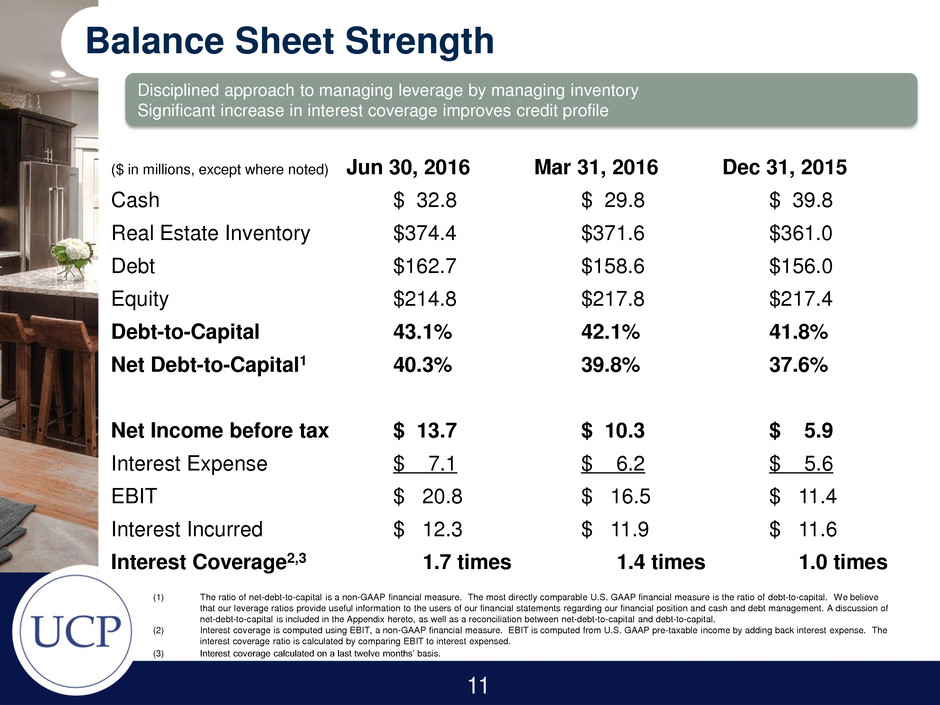
U
Balance Sheet Strength
11
Disciplined approach to managing leverage by managing inventory
Significant increase in interest coverage improves credit profile
(1) The ratio of net-debt-to-capital is a non-GAAP financial measure. The most directly comparable U.S. GAAP financial measure is the ratio of debt-to-capital. We believe
that our leverage ratios provide useful information to the users of our financial statements regarding our financial position and cash and debt management. A discussion of
net-debt-to-capital is included in the Appendix hereto, as well as a reconciliation between net-debt-to-capital and debt-to-capital.
(2) Interest coverage is computed using EBIT, a non-GAAP financial measure. EBIT is computed from U.S. GAAP pre-taxable income by adding back interest expense. The
interest coverage ratio is calculated by comparing EBIT to interest expensed.
(3) Interest coverage calculated on a last twelve months’ basis.
($ in millions, except where noted) Jun 30, 2016 Mar 31, 2016 Dec 31, 2015
Cash $ 32.8 $ 29.8 $ 39.8
Real Estate Inventory $374.4 $371.6 $361.0
Debt $162.7 $158.6 $156.0
Equity $214.8 $217.8 $217.4
Debt-to-Capital 43.1% 42.1% 41.8%
Net Debt-to-Capital1 40.3% 39.8% 37.6%
Net Income before tax $ 13.7 $ 10.3 $ 5.9
Interest Expense $ 7.1 $ 6.2 $ 5.6
EBIT $ 20.8 $ 16.5 $ 11.4
Interest Incurred $ 12.3 $ 11.9 $ 11.6
Interest Coverage2,3 1.7 times 1.4 times 1.0 times
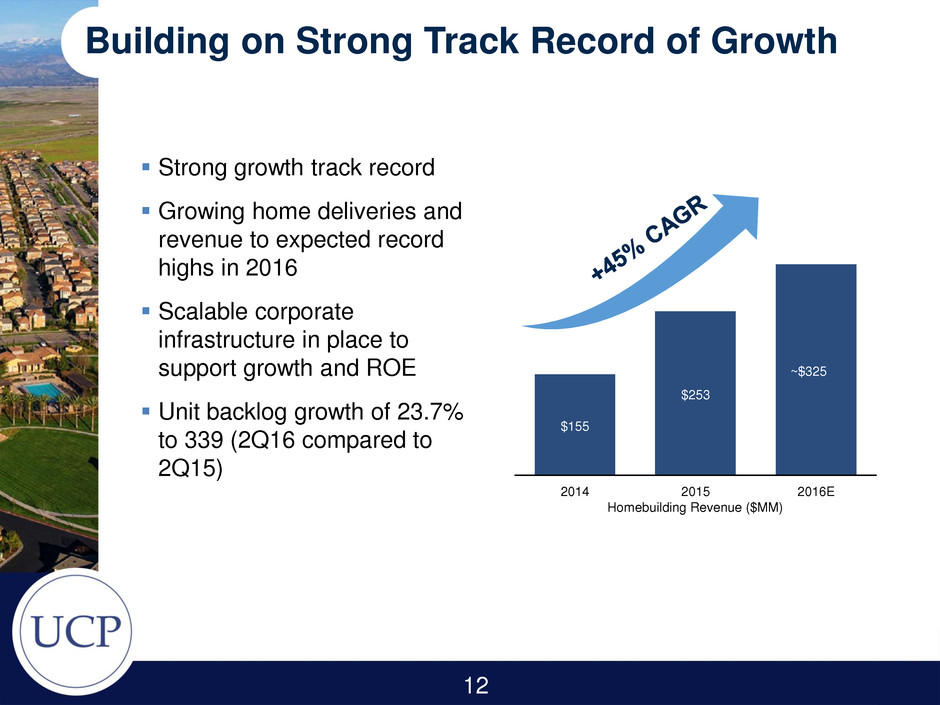
U
Building on Strong Track Record of Growth
$360k $370k
12
Strong growth track record
Growing home deliveries and
revenue to expected record
highs in 2016
Scalable corporate
infrastructure in place to
support growth and ROE
Unit backlog growth of 23.7%
to 339 (2Q16 compared to
2Q15)
$155
$253
~ ~$325
2014 2015 2016E
Homebuilding Revenue ($MM)
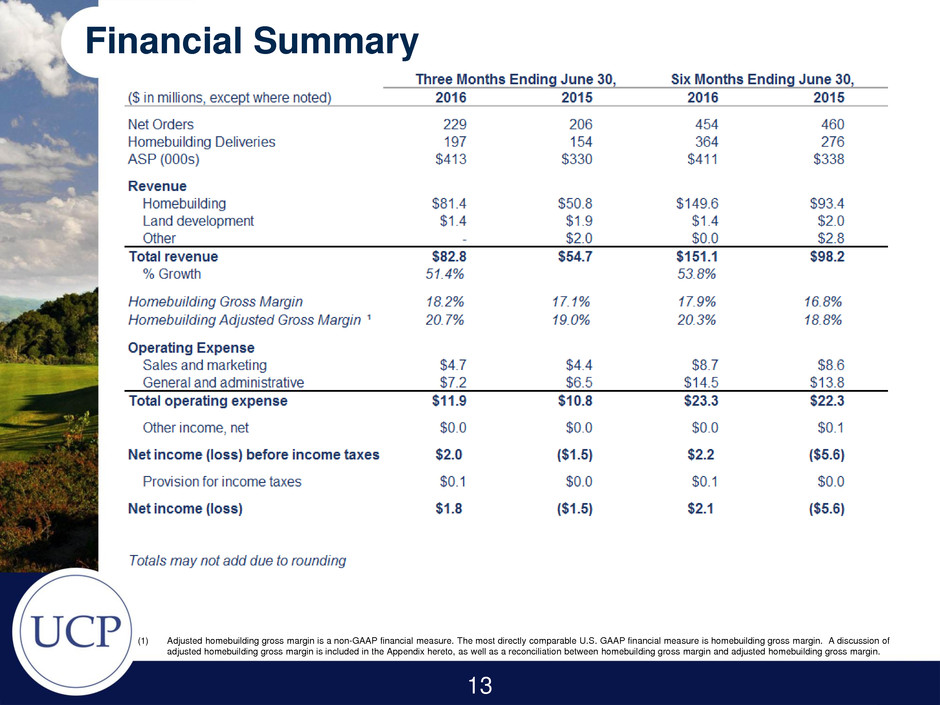
U
Financial Summary
13
(1) Adjusted homebuilding gross margin is a non-GAAP financial measure. The most directly comparable U.S. GAAP financial measure is homebuilding gross margin. A discussion of
adjusted homebuilding gross margin is included in the Appendix hereto, as well as a reconciliation between homebuilding gross margin and adjusted homebuilding gross margin.

U
Appendix – Gross Margin and Adj. Gross Margin Reconciliation
14
(1) Adjusted homebuilding gross margin percentage is a non-GAAP financial measure. The most directly comparable U.S. GAAP financial measure is homebuilding gross margin. Adjusted
gross margin is defined as gross margin plus capitalized interest, impairment and abandonment charges. We use adjusted gross margin information as a supplemental measure when
evaluating our operating performance. We believe this information is meaningful, because it isolates the impact that leverage and non-cash impairment and abandonment charges
have on gross margin. However, because adjusted gross margin information excludes interest expense and impairment and abandonment charges, all of which have real economic effects
and could materially impact our results, the utility of adjusted gross margin information as a measure of our operating performance is limited. In addition, other companies may not calculate
adjusted gross margin information in the same manner that we do. Accordingly, adjusted gross margin information should be considered only as a supplement to gross margin information
as a measure of our performance. The table above provides a reconciliation of adjusted gross margin numbers to the most comparable U.S. GAAP financial measure.
.
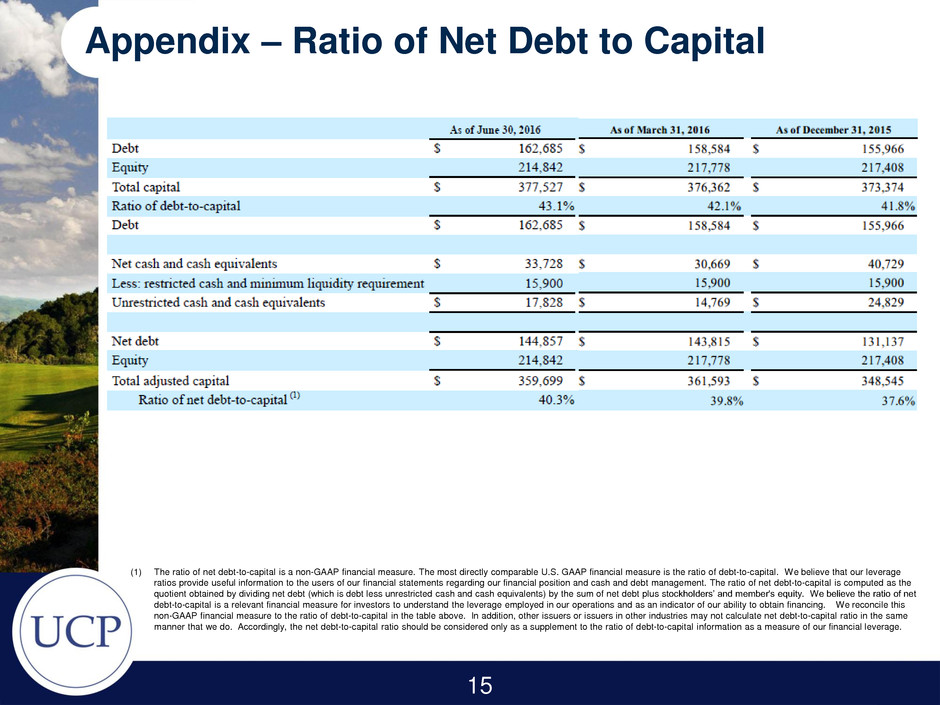
U
Appendix – Ratio of Net Debt to Capital
15
(1) The ratio of net debt-to-capital is a non-GAAP financial measure. The most directly comparable U.S. GAAP financial measure is the ratio of debt-to-capital. We believe that our leverage
ratios provide useful information to the users of our financial statements regarding our financial position and cash and debt management. The ratio of net debt-to-capital is computed as the
quotient obtained by dividing net debt (which is debt less unrestricted cash and cash equivalents) by the sum of net debt plus stockholders’ and member's equity. We believe the ratio of net
debt-to-capital is a relevant financial measure for investors to understand the leverage employed in our operations and as an indicator of our ability to obtain financing. We reconcile this
non-GAAP financial measure to the ratio of debt-to-capital in the table above. In addition, other issuers or issuers in other industries may not calculate net debt-to-capital ratio in the same
manner that we do. Accordingly, the net debt-to-capital ratio should be considered only as a supplement to the ratio of debt-to-capital information as a measure of our financial leverage.
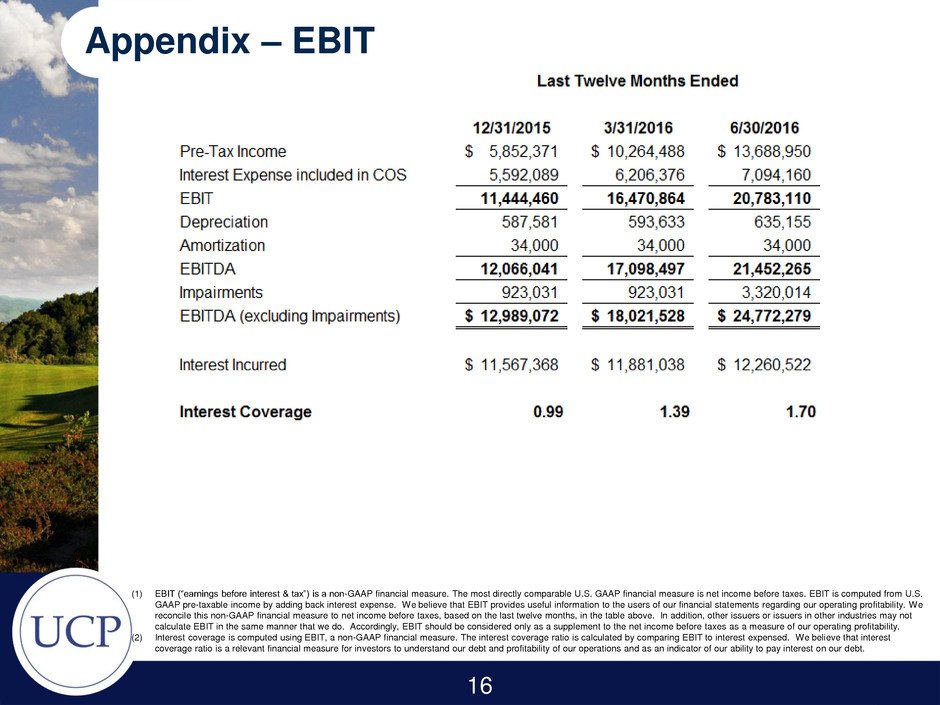
U
Appendix – EBIT
16
(1) EBIT (“earnings before interest & tax”) is a non-GAAP financial measure. The most directly comparable U.S. GAAP financial measure is net income before taxes. EBIT is computed from U.S.
GAAP pre-taxable income by adding back interest expense. We believe that EBIT provides useful information to the users of our financial statements regarding our operating profitability. We
reconcile this non-GAAP financial measure to net income before taxes, based on the last twelve months, in the table above. In addition, other issuers or issuers in other industries may not
calculate EBIT in the same manner that we do. Accordingly, EBIT should be considered only as a supplement to the net income before taxes as a measure of our operating profitability.
(2) Interest coverage is computed using EBIT, a non-GAAP financial measure. The interest coverage ratio is calculated by comparing EBIT to interest expensed. We believe that interest
coverage ratio is a relevant financial measure for investors to understand our debt and profitability of our operations and as an indicator of our ability to pay interest on our debt.
